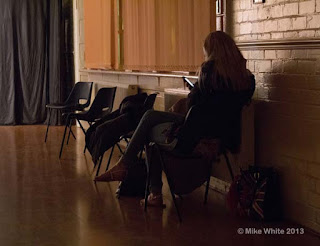The Photographers' Gallery
http://thephotographersgallery.org.uk/geraldo-de-barros-2
An exhibition of the photographic work of the artist Geraldo de Barros. Monochrome: contact prints, distressed by the artist, plus prints of A4 or thereabouts. The prints were given a lot of space and this reduced their impact, especially the tiny contacts, which seemed lost in relatively large frames. The subjects were largely abstracted; my favourites were multiple exposures of roof members, creating a lattice, e.g. Abstraction, Sao Paulo Station 1949. I was disappointed; they made very little impact on me.
http://www.guildindia.com/C.K.Rajan/Index.htm
C K Rajan: Overlaying of two contrasting newspaper or magazine images of Indian scenes. "how economic modernisation creates strong social and cultural contradictions." Three images appealed: ruined four-storey concrete buildings overlaid with the out-of-scale head and arms of a model; a flooded street, with a petrol filler nozzle, seemingly adding to the flood; A four-by-four truck jammed into a room.
http://nwermers.webs.com/collages19982011selection.htm
Nicole Wermers: her statement: "an investigation into the urban experience and the way in which the design of two and three dimensional space constructs desire, and communicates emotions and power." Collages comprising carefully selected and cut out magazine cut-outs, forming abstract images, often of humour and great beauty.
http://thephotographersgallery.org.uk/ill-form-and-void-full
Laura Letinsky: statement: "The still life genre is unavoidably a commentary on society's material mindedness and the way images promote a kind of promise of attainability."
Studio still life photographs of paper cut-outs from magazines arranged on white surfaces. Although the appropriated images incorporated were all flat pieces of paper, the result was three-dimensional. In each photograph, the cut-outs formed only a small, central group, yet were not swamped by the broad white spaces surrounding them. They suggested that the viewer had entered after an event had taken place, and that what remained was the residue. The prints were large scale and made appropriate use of the gallery space.
The Estorick Collection
http://www.estorickcollection.com/exhibitions/The main exhibition, of etchings by Giorgio Morandi, was of more interest to Suki the print-maker, than to me. Linked with it was a display of colour landscape photographs by the photographer Nino Migliori of the place where Morandi lived. http://www.photographers.it/articoli/ninomigliori.htm They were Polaroid photographs that had been distressed by the photographer, then printed at a larger size. Some of the polaroids were on display, so that one could see two stages of the process. The resulting images appeared three-dimensional; the ink and paint on the polariods seeming to float above the landscape. The mixture of small and large images was reminiscent of the Geraldo de Barros display at the Photographers' Gallery, however I found the Nino Migliori photographs to be more interesting and accessible.
Peter Fraser at Tate St Ives
(Magazine review)http://www.tate.org.uk/whats-on/tate-st-ives/exhibition/peter-fraser
Having read John Burnside's article A Liberation from the Ordinary in the Spring 2013 issue of TATE ETC, I would like to visit this exhibtion, though it's a long way. Fraser finds the strange and beautiful in what are regarded as trivial and mundane. It's a kind of photography that appeals to me very much. To find the beauty in, say, a couple of random blue buckets, is a great talent, and a delight. The fact that they're photographed at all suggests they're worthy of attention (Sontag), and study of the photograph confirms this. Burnside says, "The real world is physical and immediate and nothing is ordinary, or trivial, other than the mindset that does not know how to see what is really there." (p 58)
Since starting this course I look at faces a lot more, and find them all interesting and mostly beautiful. I think this is a similar process; a matter of seeing, rather than just looking.


















